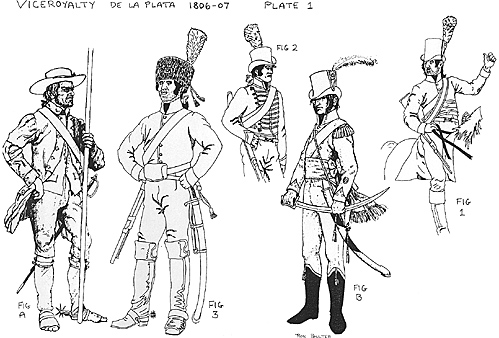Fig.1. Miqueletes Reg. Trooper. The name Miquelete comes from the province of Cataluna in Spain and means "soldier with a gun from the mountains". The regiment was organised in 1806 and took part in the 'Reconquista' under the command of Captain Jose Diaz. Under him the Miqueletes acted as a reconnaissance unit and also as Liniers' own bodyguard. Their major action on the 12th August was the attack on the Retiro position held by the British. Later in the day they took part in the attack on the Plaza Mayor. Their uniform was a cylindrical top-hat of black serge with a red cockade and yellow and red plume. The officer's plume was made from parrot's feathers. The red jacket was short with yellow collar and cuffs. They wore a yellow woollen waist sash and buff or yellow breeches, black boots and spurs. Their carbine belts were thought to be blue with white edgings. Their armament was a short carbine with a sabre in a black leather scabbard with brass fittings.
Fig.2. There was strong solidarity between the colonies in 1806 and troops from Paraguay arrived to help Liniers. They were the 'Volunteer Cavalry of Paraguay'. some 530 men strong. They were dressed in a short blue jacket with red collar and cuffs, white lace and silver buttons. Their trousers were buff cotton.
Fig.3. The company of 'Volunteers of Montevideo' were formed by Mateo Magarinos. Initially, this company was formed with 50 men. Their uniform was a hat made from sealion skin with a gold coat of arms on the front with a green engraving of the letters "VCM". The jacket was short and white with green edgings. collars and cuffs. Breeches were white and high boots were worn with spurs. Their arms consisted of a sabre, carbine and pistol. They also had a dagger which they carried in their boots. They carried with them a white standard emblazoned with the royal coat of arms of Spain on one side and the arms of the city of Montevideo on the other.
Fig.A. As an example of the way in which the dress of Liniers' men varied we have included these figures. 'The Veterans Corps of Blandenques of the Frontier of Montevideo' (A), and the 'Legion Patricia' (B). The Blandengues were a tough frontier unit of hard riders. Their uniform was an old tailcoat, sometimes cut down to make a short jacket, which was blue in colour with red collar. cuffs and lapels. Some jackets had white lace. The waistcoat and trousers were also red with white buttons. The hat was either or straw or sometimes black felt, worn with a white cover. The figure shown is wearing the local 'botas de potro' which replaced the black half boot. These were worn by the gauchos, and they were armed with lances, swords and pistols.
Fig.B. 'The Legion Patricia' was one of the best looking regiments in the army. It consisted of three battalions, 1300 in all. all born in Buenos Aires. They fought under the command of Colonel Cornelio Saavedra and showed great steadiness under fire. The regiment was noted for its bravery by the British officers, particularly during the 'Defensa' in 1807. Colonel Kington. mortally wounded, expressed his admiration when he said "in the event of my death I would like to be buried in the barracks amongst those brave men with the red shield on their left sleeve, for I would like to sleep amongst them for ever". And rest he did. Their uniform consisted of a black cylindrical felt top hat with a white plume, red cockade edged with white. They wore a short blue jacket with red collar and cuffs with three rows of gold buttons. There were also three gold buttons on the collar. On the left sleeve was worn a round red cloth shield with "Buenos Aires" embroidered in yellow thread surrounded by laurels of similar thread. A red sash was worn by officers and men around the waist and tied over the left hip. One painting also shows an officer with a red sash over his left shoulder as well as around his waist. Breeches were white, with black gaiters and shoes. Officers wore black boots and gold epaulettes. The belts were white leather with brass fittings. They carried a black leather cartridge box and bayonet scabbard.
SOURCES
Iconografia de los Uniformes Militaires, 1807... Enrique Williams Alzaga.
Historia Militar Del Uruguay... Francisco Ferrer Llull.
Uniformes Militares... Enrique Udaondo.
Private Collections of Ron Poulter, Terry Hooker.

Back to Table of Contents -- El Dorado Vol I No. 6
Back to El Dorado List of Issues
Back to MagWeb Master Magazine List
© Copyright 1989 by The South and Central Military Historians Society
This article appears in MagWeb (Magazine Web) on the Internet World Wide Web.
Other military history articles and gaming articles are available at http://www.magweb.com